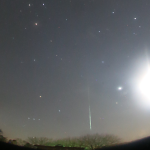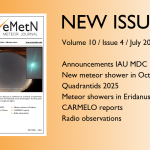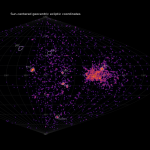Roberto Gorelli points our attention at a recently published meteor related paper:
Dynamics of spherical space debris of different sizes falling to Earth
This paper has been submitted for publication by Judit Slíz-Balogh, Dániel Horváth, Róbert Szabó and Gábor Horváth.
Abstract: Space debris larger than 1 cm can damage space instruments and impact Earth. The low-Earth orbits (at heights smaller than 2000 km) and orbits near the geostationary Earth orbit (at 35786 km height) are especially endangered, because most satellites orbit at these latitudes. With current technology space debris smaller than 10 cm cannot be tracked. Smaller space debris burn up and evaporate in the atmosphere, but larger ones fall to the Earth’s surface. For practical reasons it would be important to know the mass, composition, shape, velocity, direction of motion and impact time of space debris re-entering the atmosphere and falling to Earth. Since it is very difficult to measure these physical parameters, almost nothing is known about them. To partly fill this gap, we performed computer modelling with which we studied the celestial mechanics of spherical re-entry particles falling to Earth due to air drag. We determined the time, velocity and angle of impact as functions of the launch height, direction, speed and size of spherical re-entry particles. Our results can also be used for semi-spherical meteoroid particles of the interplanetary dust entering the Earth’s atmosphere.
You can download this paper for free: https://arxiv.org/pdf/2006.00853.pdf (16 pages).
Prof. Gábor Horváth informs MeteorNews that this paper and its supplement can be downloaded from the following addresses:
https://arago.elte.hu/sites/de
https://arago.elte.hu/sites/de
Supplementary Video Clips can be downloaded from the following addresses:
- http://fizikaiszemle.hu/extra/
Horvath2006/1/Urszemet-Videokl ipp_VC1.mp4 - http://fizikaiszemle.hu/extra/
Horvath2006/2/Urszemet-Videokl ipp_VC2.mp4 - http://fizikaiszemle.hu/extra/
Horvath2006/3/Urszemet-Videokl ipp_VC3.mp4 - http://fizikaiszemle.hu/extra/
Horvath2006/4/Urszemet-Videokl ipp_VC4.mp4 - http://fizikaiszemle.hu/extra/
Horvath2006/5/Urszemet-Videokl ipp_VC5.mp4 - http://fizikaiszemle.hu/extra/
Horvath2006/6/Urszemet-Videokl ipp_VC6.mp4 - http://fizikaiszemle.hu/extra/
Horvath2006/7/Urszemet-Videokl ipp_VC7.mp4
Older meteor library news:
2020
- Near-infrared observations of active asteroid (3200) Phaethon reveal no evidence for hydration, by Driss Takir, Theodore Kareta, Joshua P. Emery, Josef Hanuš , Vishnu Reddy, Ellen S. Howell, Andrew S. Rivkin & Tomoko Arai (1 May 2020).
- Measuring Fluxes of Meteor Showers with the NASA All-Sky Fireball Network, by Steven Ehlert and Rhiannon Blaauw Erskine (20 April 2020).
- Where did they come from, where did they go. Grazing fireballs, by P. M. Shober, T. Jansen-Sturgeon, E. K. Sansom, H.A.R. Devillepoix, M.C. Towner, P.A. Bland, M. Cupák, R.M. Howie, and B.A.D. Hartig (12 April 2020).
- The Quadrantids and December alpha Draconids 2012-2019 – Multi-year Meteor Videography, by Alex Pratt (9 April 2020).
- Characterization of the June epsilon Ophiuchids meteoroid stream and the comet 300P/Catalina, by Pavol Matlovič, Leonard Kornoš, Martina Kováčová, Juraj Tóth and Javier Licandro (7 April 2020).
- The hazard from fragmenting comets, by W.M. Napier (7 April 2020).
- A Real-Time Search for Interstellar Impacts on the Moon, by Amir Siraj and Abraham Loeb (7 April 2020).
- A Global Fireball Observatory, by H. A. R. Devillepoix, M. Cupák, , P. A. Bland, , E. K. Sansom, M. C. Towner, R. M. Howie, B. A. D. Hartig, T. Jansen-Sturgeon, P. M. Shober, S. L. Anderson, G. K. Benedix, D. Busan, R. Sayers, P. Jenniskens, J. Albers, C. D. K. Herd, P. Carlson, P. J. A. Hill, P. G. Brown, Z. Krzeminski, G. R. Osinski, H. Chennaoui Aoudjehane, T. Shisseh, Z. Benkhaldoun, A. Jabiri, M. Guennouni, A. Barka, H. Darhmaoui, L. Daly, G. S. Collins, S. McMullan, M. D. Suttle, C. Shaw, J. S. Younga, M. Alexander, A. D. Mardon, T. Ireland, G. Bonning, L. Baeza, T. Y. Alrefay, J. Horner, T. D. Swindle, C. W. Hergenrother, M. D. Fries, A. Tomkins, A. Langendam, T. A. Rushmer, C. O’Neill, D. Janches and J. L. Hormaechea (3 April 2020).
- Realistic gravitational focusing of meteoroid streams, by Althea V. Moorhead, Tiffany D. Clements, and Denis Vida (14 March 2020).
- On the delivery of DART-ejected material from asteroid (65803) Didymos to Earth, by Paul Wiegert (5 March 2020).
- Physically based alternative to the PE criterion for meteoroids, by Manuel Moreno-Ibáñez, Maria Gritsevich, Josep M. Trigo-Rodríguez, Elizabeth A. Silber. (3 March 2020).
- Hemolithin: a Meteoritic Protein containing Iron and Lithium, by Malcolm. W. McGeoch, Sergei Dikler and Julie E. M. McGeoch (28 February 2020).
- Orbital dynamics of highly probable but rare Orionid outbursts possibly observed by the ancient Maya, by J. H. Kinsman and D. J. Asher (22 February 2020).
- A new method for measuring the meteor mass index: application to the 2018 Draconid meteor shower outburst, by D. Vida, M. Campbell-Brown, P. G. Brown, A. Egal, and M. J. Mazur (11 February 2020).
- A Two Year Survey for VLF Emission from Fireballs, by C. Y. Sung, P. Brown and R. Marshall (11 February 2020).
- Observational Signatures of Sub-Relativistic Meteors, by Amir Siraj and Abraham Loeb (6 February 2020).
- Supercatastrophic disruption of asteroids in the context of SOHO comet, fireball and meteor observations, by Paul Wiegert, Peter Brown, Petr Pokorny, Quanzhi Ye, Cole Gregg, Karina Lenartowicz, Zbigniew Krzeminski and David Clark. (28 January 2020).
- Physical properties of Taurid meteoroids of various sizes, by Jiří Borovička and Pavel Spurný. (27 January 2020).
- The orbital clusters among the near Earth asteroids, by Tadeusz J. Jopek. (27 January 2020).
2019
- Parker Solar Probe Observations of a Dust Trail in the Orbit of (3200) Phaethon, by Karl Battams, Matthew M. Knight, Michael S.P. Kelley, Brendan M. Gallagher, Russell A. Howard, and Guillermo Stenborg. (22 December 2019).
- Meteoroid Stream Formation Due to the Extraction of Space Resources from Asteroids, by Logan Fladeland, Aaron C. Boley, and Michael Byers. (2 December 2019).
- Estimating trajectories of meteors: an observational Monte Carlo approach – II. Results, by Denis Vida, Peter G. Brown, Margaret Campbell-Brown, Paul Wiegert and Peter S. Gural. (27 November 2019).
- Estimating trajectories of meteors: an observational Monte Carlo approach – I. Theory, by Denis Vida, Peter S. Gural, Peter G. Brown, Margaret Campbell-Brown and Paul Wiegert. (11 November 2019).
- Meteor shower activity profiles and the use of orbital dissimilarity (D) criteria, by Althea V. Moorhead. (25 October 2019).
- A fireball and potentially hazardous binary near-Earth asteroid (164121) 2003 YT1, by Toshihiro Kasuga, Mikiya Sato, Masayoshi Ueda, Yasunori Fujiwara, Chie Tsuchiya, and Jun-ichi Watanabe. (18 October 2019).
- Spectral and orbital survey of medium-sized meteoroids, by Pavol Matlovic, Juraj Tóth, Regina Rudawska, Leonard Kornoš and Adriana Pisarcíková. (7 August 2019).
- Rising from Ashes or Dying Flash? Mega Outburst of Small Comet 289P/Blanpain in 2013, by Quanzhi Ye (叶泉志) and David L. Clark. (19 June 2019).
- Discovery of a Meteor of Interstellar Origin, by Amir Siraj and Abraham Loeb. (10 June 2019).
- A Mathematical Model for Simulating Meteor Showers, by M. Cardinot and A. Namen. (4 June 2019).
- The 2019 Taurid resonant swarm: prospects for ground detection of small NEOs, by David Clark, Paul Wiegert and Peter G. Brown. (28 May 2019).
- Analysis of the June 2, 2016 bolide event over Arizona, by Csaba Palotai, Ramanakumar Sankar, Dwayne L. Free, J. Andreas Howell, Elena Botella and Daniel Batcheldor. (25 May 2019).
- Identifying Interstellar Objects Trapped in the Solar System through Their Orbital Parameters, by Amir Siraj and Abraham Loeb. (5 May 2019).
- Meteor Shower Modeling: Past and Future Draconid Outbursts, by A. Egal, P. Wiegert, P. G. Brown, D. E. Moser, M. Campbell-Brown, A. Moorhead, S. Ehlert and N. Moticska. (1 May 2019).
- Meteoroid structure and fragmentation, by M. D. Campbell-Brown. (24 March 2019).
- Solar cycle variation in radar meteor rates, by M. D. Campbell-Brown. (26 February 2019).
- A New Meteoroid Model, by Valeri V. Dikarev, Eberhard Grün, William J. Baggaley, David P. Galligan, Markus Landgraf, Rüdiger Jehn. (12 February 2019).
- Lunar impacts, by Costantino Sigismondi. (12 February 2019).
- Lunar impact flashes, by C. Avdellidou and J. Vaubaillon. (10 February 2019).
- The Geminid parent body: (3200) Phaethon, by Patrick A. Taylor, Edgard G. Rivera-Valentín, Lance A.M. Benner, Sean E. Marshall, Anne K. Virkki, Flaviane C.F. Venditti, Luisa F. Zambrano-Marin, Sriram S. Bhiravarasu, Betzaida Aponte-Hernandez, Carolina Rodriguez Sanchez-Vahamonde and Jon D. Giorgini. (10 February 2019).
- Sun approaching asteroids and meteor streams, by Quanzhi Ye and Mikael Granvik. (10 February 2019).
2018
- Waiting to make an impact: A probable excess of near-Earth asteroids in 2018 LA-like orbits, by C. de la Fuente Marcos and R. de la Fuente Marcos. (18 December 2018).
- What mechanisms dominate the activity of Geminid Parent (3200) Phaethon?, by LiangLiang Yu, Wing-Huen Ip and Tilman Spohn. (6 November 2018).
- The Draconid meteoroid stream 2018: prospects for satellite impact detection, by Auriane Egal, Paul Wiegert, Peter G. Brown, Danielle E. Moser, Althea V. Moorhead and William J. Cooke (21 September 2018).
- Modeling the measurement accuracy of pre-atmosphere velocities of meteoroids, by Denis Vida, Peter G. Brown and Margaret Campbell-Brown (15 July 2018).
2017
- The Mayas and Eta Aquariids in AD 250-909, by J.H. Kinsman and D.J. Asher (31 July 2017).





